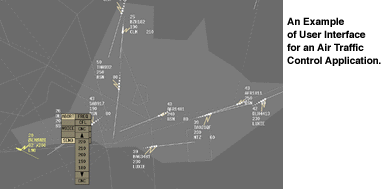Mefisto: Designing User Interfaces for Air Traffic Control
by Fabio Paternò
The Mefisto project intends to contribute to the design of user interfaces for safety critical interactive systems with special reference to Air Traffic Control (ATC) applications. With the predicted increases in the volume of air traffic for the next millennia, software solutions to problems of air traffic control are attractive. The aim is to develop a method with associated tools and techniques for engineering the design, development and evaluation of user interfaces for ATC systems. The method will be applicable to other safety critical interactive systems.
Air traffic forecasts are normally based on passenger demand and economic factors, under the assumption that there is no limitation in the air traffic system itself; however, it is obvious that there are constraints limiting the expansion of the number of flights. The number and duration of delays, especially during peak hours (estimated at a cost of 2 billion dollars annually) show that ATC and airports are not always able to cope with the demand. This growing air traffic increases the possibility of accidents and requires more sophisticated techniques for its management. An approach is needed that can support the design of user interfaces satisfying both usability and safety requirements.
Air Traffic Control is an important application area for European industry, and one in which many problems remain to be solved. For example, several air traffic control incidents have occurred because of the undesired effects of interactions of operators or the lack of efficiency of current systems; this results, at best, as a waste of time both for air traffic controllers and for pilots.
The novelty of the Mefisto project lies in the application of recent software technologies (multimodal user interfaces with possible vocal and data links) to a relevant application area (Air Traffic Control). Formal models are used to address both software problems (such as the choice of the media to support user interactions and the design of the structure of the software architecture) and human related factors (such as the influence of task structure and cognitive capabilities on the software specification). This structured approach contrasts with the more commonly used direct manipulation interface development tools that, while suitable for generating simple graphical interfaces, are less appropriate for complex requirements or novel interfaces. In addition the approach deals with the design of user interfaces for usable, safety critical applications by providing formalisms, design rules and tools for the engineering of such applications. We want to capture usability and safety requirements for ATC applications and check their satisfaction at both the formal specification and the implementation levels. We do not intend to deal with all usability and safety requirements. We are interested in a representative set of requirements at the intersection of these two viewpoints on the system. We develop and use various tools to support the different phases of the design cycle: to express the task model, to translate it into an architectural model, to verify properties of the possible user-application dialogues, to prototype implementations, to evaluate the usability of prototypes.
Mefisto has three main objectives:
- to design a method which allows designers to develop ATC user interface specifications and related software implementations which satisfy usability and safety requirements. This would allow software designers and developers to reduce the costs of their work as it is easier and cheaper to correct errors and bad design choices in the first phases of the design and development cycle. The formal approach can be used to provide some performance evaluation in a system model which is obtained in a task-driven way. We aim at eliciting and verifying a set of criteria to establish, during the design process, whether a system will reach a satisfactory quality level for the end user.
- to develop a set of automatic tools supporting the method and allowing designers to address large size, industrially relevant, case studies. Some tools are developed from scratch, others by modifying existing tools. Different tools will address different phases: formal specification verification, software prototyping from specifications, usability evaluation. Most of the phases of the global method developed will be semi-automatic so as to allow designers to concentrate on semantically relevant aspects, and will have automatic support for repetitive processing. The method developed guarantees that the software implementation of the multimodal user interface must fulfil the requirements verified over the formal specification.
- to implement ATC user interface prototypes which are validated against usability and safety requirements by formal specification and empirical testing. They will provide concrete examples for end users (air traffic controllers) indicating how new methods and technologies can optimise their work in front of the growing complexity caused by the increase in air traffic. The usability evaluation takes into account empirical evaluations and the models (user, task, architectural models) used to drive software design and development. It is tool-supported to manage the large volume of data which can be collected while the users are testing the prototypes.
The MEFISTO project is a three-year Reactive Long Term Research in the Esprit Programme which started in September '97. CNUCE-CNR is the prime contractor of the consortium which also includes Alenia (a developer and supplier of ATC/ATM systems), CENA (Centre d'Etudes de la Navigation Aerienne, in cooperation with SOFREAVIA), University of Toulouse I, University of York, DRA-DERA (Defence Evaluation and Research Agency of the UK Ministry of Defence), E.N.A.V. (the Italian association of air traffic controllers) and University of Siena. For more information on MEFISTO see: http://giove.cnuce.cnr.it/mefisto.html
Please contact:
Fabio Paternò - CNUCE - CNR
Tel: +39 50 593289
E-mail: f.paterno@cnuce.cnr.it

